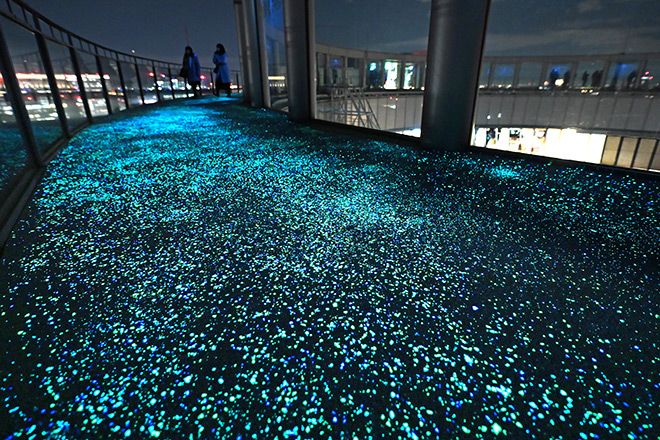OSAKA–After sunset when Osaka’s central Umeda district dazzles with vibrant neon lights, visitors head upward to enjoy the view from a heavenly perch.
They flock to the Kuchu Teien (aerial garden) Observatory located on the rooftop of the 170-meter-high Umeda Sky Building in the city’s Kita Ward.
The unique-looking structure consists of two 40-story towers connected at the top floors.
The skyscraper was designed by architect Hiroshi Hara, who passed away in January this year, apparently taking inspiration from the ruins of the Hanging Gardens of Babylon in Iraq and other legendary sites.
The observatory offers an enchanting 360-degree view of Osaka and its surrounding areas, including Osaka Bay and the Ikoma Mountains, making visitors feel closer to the city nightscape and the sky.
But what commands the attention first is the walking path under the feet.
As dusk nears, the path begins to be lit up in spots.
It is sprinkled with an infinite number of fluorescent stones, which absorb ultraviolet rays to glow in blue, purple and green.
Lit by black light during the day, the stones glimmer under all weather conditions.
The 122-meter-long Lumi Sky Walk path around the observatory was initially introduced in 2007.
It reopened in 2023 after the fluorescent stones were replaced with smaller ones measuring about 5 millimeters to make it look like a nebula in the dark night sky.
Visitors can enjoy spotting the illuminated stones grouped into the shapes of the Earth and Saturn.
A telescope is also set up for visitors to observe the full moon during a regular viewing event offered at no extra charge.
In addition, a public star observing session is held once a month.
According to Hiroyuki Mametani, 62, a curator at the Osaka Museum of History, the area surrounding JR Osaka Station had been farmland away from Osaka Castle between the Edo Period (1603-1867) and the early Meiji Era (1868-1912).
The Umeda graveyard was also located in the center of the agricultural village.
“I assume it was a really quiet place,” Mametani said.
When the Umeda Sky Building, which is managed by Sekisui House Umeda Operation Co., was completed in 1993, there were no other buildings in the surrounding area that were as high as there are today.
Although the landmark attracted more than 1 million people in the year it opened, the annual visitor number fell below 500,000 at some point.
But the number of foreign tourists sharply increased after it was listed alongside the Sagrada Familia in Spain and other famed structures as one of the top 20 buildings around the world by a British publisher in 2008.
With many commercial buildings opening as part of urban development projects in the area around the station, the pedestrian flow has also changed.
The annual number of visitors from February 2024 hit 1.66 million, marking a record high.
Nana Takase, who is in charge of planning and hosting astronomical observation events, goes up to the observatory every day if she can.
“The landscape consisting of the glowing city landscape, the night sky and the night cityscape is the pinnacle of luxury,” Takase said. “Because you can never see the same view twice, you can’t expect what is waiting for you until you go up there.”
(This article was written by Sachi Otsuta and Nobuhiro Shirai.)


AloJapan.com